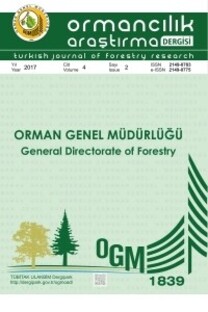Farklı vaks türlerinin lif levhaların bazı fiziksel ve yüzey özellikleri üzerindeki etkinliğinin değerlendirilmesi
Lif levha, su iticilik, vaks, balmumu, soya vaksı
The evaluation of the efficiency of different waxes on some physical and surface properties of fiberboard
Fiberboard, water repellency, wax, beewax, soy wax,
___
- Adgaba, N. (2007). Physical and chemical properties of Ethiopian beeswax and detection of adulteration. Ethiopian journal of Animal production, 39.
- Akcay, C. (2020). Determination of decay, larvae resistance, water uptake, color, and hardness properties of wood impregnated with honeybee vax. BioResources, 15(4), 8339.
- Amin, M., Putra, N., Kosasih, E. A., Prawiro, E., Luanto, R. A., & Mahlia, T. M. I. (2017). Thermal properties of beeswax/graphene phase change material as energy storage for building applications. Applied Thermal Engineering, 112,273-280. DOI:10.1016/j.applthermaleng.2016.10.085
- Chen, J., Wang, Y., Cao, J., & Wang, W. (2020). Improved water repellency and dimensional stability of wood via impregnation with an epoxidized linseed oil and carnauba vaks complex emulsion. Forests, 11(3), 271.
- DIN 4768 (1990) Determination of values of surface roughness parameters Ra, Rz, Rmax using electrical contact (stylus) instruments, concepts and measuring conditions. Deutsches Institut für Norming, Berlin, Germany.
- EN 317 (1993). Particleboards and Fiberboards, Determination of Swelling in Thickness After Immersion, European Committee for Standardization, Brussels, Belgium.
- Eroğlu H. ve Usta M. (2000), Lif levha üretim teknolojisi, KTÜ. Orman Fakültesi Yayın, 200-30, Trabzon.
- Grigsby, W., & Thumm, A. (2012). The interactions between wax and UF resin in medium density fibreboard. European Journal of Wood and Wood Products, 70(4), 507-517.
- Ibrahim, A. I. (2020). Production of Water Repellent Coating Using Beeswax and Soy Wax. In 7th International Conference on islamic education 2020 (ICIEd 2020) (p. 661).
- Khan, K. A., Ali, M. H., Obaydullah, A. K. M., & Wadud, M. A. (2019). Production of candle using solar thermal technology. Microsystem Technologies, 25(12),4505-4515. DOI:10.1007/s00542-019-04390-7
- Kryński, K., & Kowaluk, G. (2021). Application of beeswax as a hydrophobic agent in MDF technology. Annals of Warsaw University of Life Sciences-SGGW. Forestry and Wood Technology.
- Lesar B, and Humar M. (2011), Use of wax emulsions for improvement of wood durability and sorption properties. European Journal of Wood and Wood Products, 69(2), 231-238. DOI:10.1007/s00107-010-0425-y
- Li, Y., Qian, J., Wang, Z., Qu, L., Gao, J., Yi, S., & He, Z. (2020). Effect of beeswax impregnation on the dimensional stability, surface properties, and thermal characteristics of wood. BioResources, 15(2), 2181-2194.
- Lötter B.T ve Evans P. D. (2019) Sprayable hot melt waxes as water repellents for oriented strand board, International Wood Products Journal, 10:3, 102-110, DOI: 10.1080/20426445.2019.1637609 Németh, R., Tsalagkas, D., & Bak, M. (2015). Effect of soil contact on the modulus of elasticity of beeswax-impregnated wood. BioResources, 10(1), 1574-1586. Ren, L., Cai, Y., Ren, L., & Yang, H. (2016). Preparation of Modified Beeswax and Its Influence on the Surface Properties of Compressed Poplar Wood. Materials, 9(4), 230.
- Scholz, G., Militz, H., Gascón-Garrido, P., Ibiza-Palacios, M. S., Oliver-Villanueva, J. V., Peters, B. C., & Fitzgerald, C. J. (2010). Improved termite resistance of wood by wax impregnation. International Biodeterioration & Biodegradation, 64(8), 688–693. DOI:10.1016/j.ibiod.2010.05.012
- Shen, T., Fan, S., Li, Y., Xu, G., & Fan, W. (2020). Preparation of edible non-wettable coating with soybean wax for repelling liquid foods with little residue. Materials, 13(15), 3308.
- Tinto, W. F., Elufioye, T. O., and Roach, J. (2017). Waxes. Pharmacognosy, 443–455. DOI:10.1016/b978-0-12-802104-0.00022-6
- Youngquist, J. A. (1999). Wood-based composites and panel products. Wood handbook: wood as an engineering material. Madison, WI: USDA Forest Service, Forest Products Laboratory, 1999. General technical report FPL; GTR-113: Pages 10.1-10.31, 113.
- URL-1:https://pediaa.com/what-is-the-difference-between-beeswax-and-soy-wax/
- ISSN: 2149-0783
- Yayın Aralığı: Yılda 2 Sayı
- Başlangıç: 2014
- Yayıncı: ahu peruzhan ÖZYAKUP
Ormancılıkta iş tanımının önemi (hizmet vasıtası şoförü örneği)
İsmail ŞAFAK, Mehmet EKER, Hadiye BAŞAR, Süleyman OKUMUŞ
Uğur ÖZKAN, Sebnem Sevil ARPACI, Eylem DİZMAN TOMAK
Polivinil klorür (PVC)’ün geri dönüştürülmesi: PVC köpük üretimi ve Karakterizasyonu
Yıldız BİRBİLEN, Kadir KARAKUS, Fatih MENGELOĞLU
Bazı ağaç türlerinde mikrodalga uygulamasının verniklerin parlaklık direnci üzerine etkisi
Çiğdem KASA, Özlem BOZDOĞAN BALÇIK, Turgay ÖZDEMİR
Ormancılık Araştırma Enstitüsü Müdürlüklerinde çalışan işçi personelin özellikleri
Küreselleşme sürecinde odun esaslı levha üretim ve dış ticaret durumunun analizi
Aytaç AYDIN, Sebahattin TİRYAKİ, Hakan ADANUR
İç ortam kullanım yerlerinde güneş ışınlarının ahşabın özelliklerine etkisi
Uğur ÖZKAN, Eylem DİZMAN TOMAK
Yılmaz TÜRK, Berkan BALABAN, Ece ALKAN, Tunahan ÇINAR, Abdurrahim AYDIN
